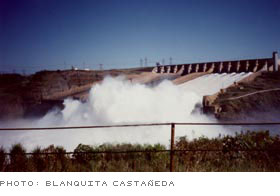|
Brazil and Paraguay joined efforts almost three decades ago to build the Hydroelectric Plant at Itaipu, the biggest in the world in operation. A survey carried out by the American Association of Civil Engineers (AACE), among professionals from different countries, made a list of the seven marvels of the modern world, published in 1995 by “Popular Mechanics” magazine. On this list Itaipu is joined by: the Golden Gate bridge of San Francisco; the Panama Canal; The Euro tunnel that joins England and France under the Canal of la Mancha; The Water Control System of the North Sea in Holland, the Empire State building in New York, and the Canadian National Tower.
The Plant at Itaipu is the result of intense negotiations begun in the middle 60s between Brazil and Paraguay, which acquire legal shape with the Treaty of Itaipu, signed April 26, 1973. Thus begins the hydroelectric exploitation of the plentiful and extensive Parana River, precisely at the border between those two countries. In May of 1974 the Itaipu Bi-national Entity is created to build and operate the Hydroelectric Plant, and in January of the following year work is begun. In October of 1982 the dam is concluded, and upon closing the floodgates the Plant’s reservoir begins to take shape. In only 14 days the Lake of Itaipu is created over an area of 1350 squared km.
In May of 1984, only ten years after the creation of the Bi-national, the first energy-generating unit began to operate. Presently, with 18 units, the Plant annually produces more than 93,000 million kilowatts per hour, well above any other in the world and 20% above the previsions of the project itself. Nevertheless, technological need was not a reason to harm nature. From its very beginnings was established a strict relationship with the environment. Expert environmentalists hired by the Bi-national explored the whole reservoir area, saving hundreds of animal species, and creating biological refuges to stimulate a future repopulation of forests with fauna from the region. Native forests were preserved and reforested, some of them already devastated by old agricultural methods. Twenty million trees were plated during the first phase of operations. The Museum of Natural History was created, the Zoo of Itaipu, the Tati Yupi refuge and the Itabo Ecological Reserve as additional protective, educational and tourist attraction efforts.
Agriculture, the area’s economic foundation, has been displaced by tourist activity, supported by more than 10 million visitors from 164 countries that want to experience the details of one of the 7 marvels of modern engineering. Several artificial beaches and excellent tourist facilities have been created near the edges of the lake, where all kinds of nautical sports can be practiced. Thus, within the great area of influence of Itaipu’s hydroelectric Plant are united the most up-to-date technology, respect for nature, and the development of new productive activities. All together with the enterprising spirit of two countries determined to forge their own destiny. Itaipu, an example of the best of the latin spirit. |
|
|
 Can
two Latin American countries have built one of the 7 marvels of
the modern world?
Can
two Latin American countries have built one of the 7 marvels of
the modern world?